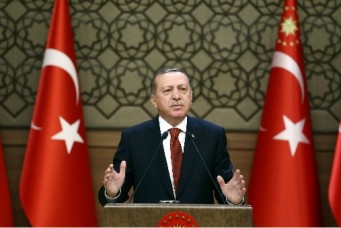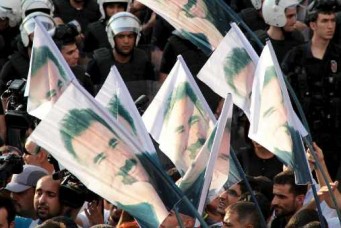Gezi Park’s Soccer Fanatics
Protests in Gezi Park continue to be a powerful symbol against Turkish Prime Minister Recep Tayyip Erdogan and Erdogan’s Justice and Development Party. However, few outside of Turkey know that the “hooligan” soccer fans of Istanbul were instrumental in the first days of the Gezi Park occupation and protest.

Protest by members of Çarşı, the largest soccer fan club in Turkey, Istanbul, June 8, 2013. Sean David Hobbs for the Cairo Review.
Protests in Gezi Park continue to be a powerful symbol against Turkish Prime Minister Recep Tayyip Erdogan and Erdogan’s Justice and Development Party (or AKP). In weekly demonstrations across Turkey activists chant, “Resistance is everywhere!” The most important example of this continuing resistance is weekend park meetings organized by protestors in neighborhood parks across Turkey. These park meetings are popular, animated with the feeling that the Gezi Park movement endures and has propelled hundreds of smaller meetings. Attendees talk about challenging the AKP in the 2014 municipal and 2015 national elections. Beyond party politics, park meeting attendees openly discuss the creation of a new society. However, few outside of Turkey know that the “hooligan” soccer fans of Istanbul were instrumental in the first days of the Gezi Park occupation and protest.
On June 1, triggered by reports of brutal police repression against a small group of environmentalists protecting Gezi Park, people from all walks of life gathered in the pre-dawn hours throughout Istanbul. Beating pots and pans, protestors cried for the end of Erdogan and the AKP.
In many ways the AKP’s own policies created the Gezi Park protest. Mass privatization under Erdogan made Turkey richer than ever before. Yet the new money was not evenly distributed. Unemployment was high and the minimum wage was low. While the economy grew so too did Erdogan’s infrastructure projects, which were bid off to AKP-friendly industries, which cared little about the environment. Erdogan often played the religious card, positioning himself as a good Islamist. He called all abortions murder, said that every Turkish family should have at least three children, and even pushed for male and female segregated pools in resort towns. Leading up to the Gezi Park protest the AKP had given the building rights on Gezi Park to a corporate group intent on destroying the park and building a mall and a mosque in Istanbul’s final downtown green space. It was this combination of anti-environmental privatization and overt Islamism, that got out anti-AKP Turks in the middle of the night.
One group of protestors—over six thousand people—marched toward Gezi Park. Platoons of Turkish swat police met the crowd at the port district of Beşiktaş along the Bosphorus. Behind the officers were police tanks. The swat teams were in full body armor, wearing helmets and gas masks. As the crowd of protestors approached, the police were loading their tear gas and noise bomb guns.
Some people shouted fearfully, “My God, my God! Look at what is across from us!” Then from behind came truck horns. A group of Mack Trucks approached driven by soccer fans of Turkey’s three great soccer teams, Beşiktaş, Fenerbahçe and Galatasaray. The soccer fans were wearing their team jerseys and waving team flags. The protestors cheered that reinforcements had arrived!
The Mack trucks pulled forward and acted as protection from the tear gas, noise bombs and water cannon of the police. With the trucks covering the crowd, soccer fans led the protesters. They built barricades by tearing fences from sidewalks, overturning trash bins, and dragging old cars to the road. Cement blocks were smashed to throwing stones, which hungry hands grabbed and threw at the police. In turn, the police pushed the Mack trucks back and shot tear gas and noise bombs directly into the crowd.
The protestors stood fast, however. The crowd began to chant in Turkish at the security forces:
Shoot, let’s see!
Shoot, let’s see!
Shoot your tear gas, let’s see!
Take off your gas mask!
Leave your bully-club behind!
And then let’s see who the real men are!
As dawn broke police tanks and swat teams pulled off the streets. Hundreds of thousands moved in union across the Bosphorus bridge. A few hours later, with Turkey’s soccer fans in the lead, the people of Istanbul occupied Gezi Park and Taksim Square.
What came next was the expansion of the Gezi Park protest movement. Unprecedented in Turkey or the rest of the Middle East, millions came to openly discuss homosexuality, feminism, minority rights, Islamism, nationalism and capitalism. Gezi Park became a quilt of organizations and people; patch-worked over the green space of downtown Istanbul. One member of the soccer fan group Tek Yumruksaid, “The important thing that I find about Gezi Park is that so many different people who used to be opposed to one another are now talking openly about creating a new Turkey.”
While an important event, the occupation of Gezi only lasted two weeks. On the evening of June 15, Erdogan ordered Turkish police forces back into the park. In the resulting street clashes, thousands were tear gassed, arrested and injured.
In the past few months the AKP has re-landscaped Gezi Park and promised not to destroy it. Hundreds of police patrol the sensitive site and bar any large group from entering. The police and other state controlled institutions have arrested or intimidated many protestors who opposed Erdogan and the AKP at Gezi Park. Recently the AKP hired some six thousand bloggers to monitor Twitter and Facebook in order to get out the party’s side on social media.
For many it is heartbreaking that Erdogan and the AKP have come to this. At one time AKP was the hope of democracy in Turkey and the Middle East. The AKP removed the once oppressive Turkish army from politics. Infrastructure projects, new schools and hospitals now cover the country. Economic growth has sky rocketed; IMF loans have been paid off. In the process, the AKP has become the ruling hegemon by being the biggest privatizers in the country.
The Gezi Park protests show the limitations of Erdogan’s AKP as a model for the rest of the Middle East. Without an equal sharing of the new wealth, class dynamics have become enflamed around the issues of Islamism and environmentalism. Instead of working through these issues with dissidents, the AKP has resorted to oppressive police crackdowns and intimidation. Recent polls show that support for the AKP has dropped by 10 to 15 points.
The best hope for Turkey would be a coalition government led Sirri Sureyya Onder, a progressive Kurdish rights leader and seconded by Numan Kurtulmus, a progressive Islamist. Onder is an independent voice in Turkish politics, supported by many who participated in the Gezi Park protest. Meanwhile, Kurtulmus can bring some AKP supporting Islamists into any future coalition government to heal the social divisions caused by Gezi Park. With these two leaders it is possible to see a Turkey where human rights for all could transform the country and make it into a real international model in the twenty-first century. Yet will this happen given AKP’s dominant and (some say) dictatorial power?
In the short term AKP will continue to solidify its hold on power. However, Erdogan’s government has strayed dangerously into un-democratic practices. Ultimately the desire for a democratic society as exemplified in Gezi Park is more powerful than AKP state sponsored repression.
Sean David Hobbs is a reporter-researcher for the Cairo Review of Global Affairs. He has reported from Istanbul for five years.
Subscribe to Our Newsletter




